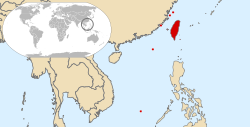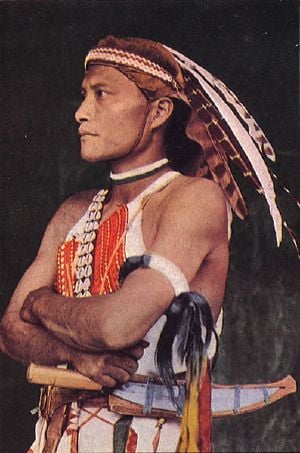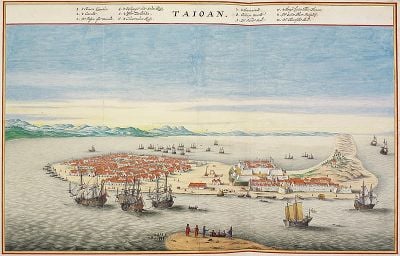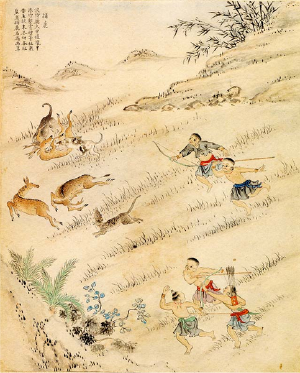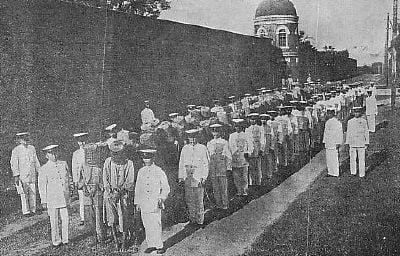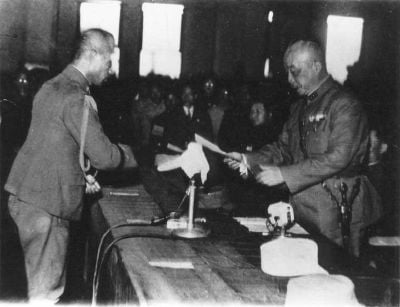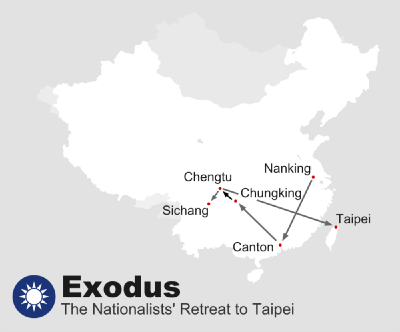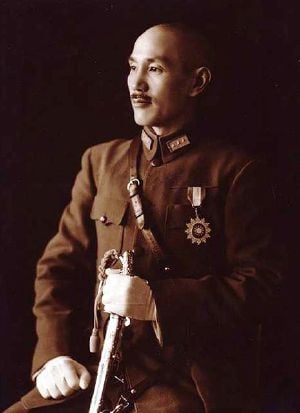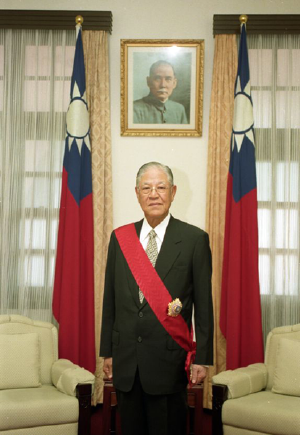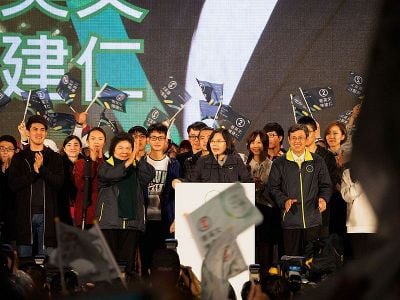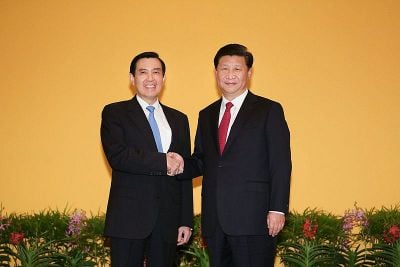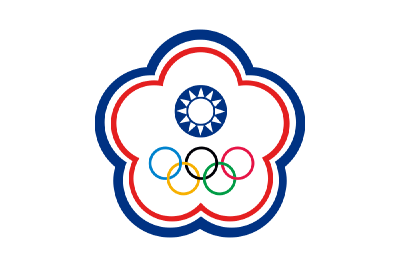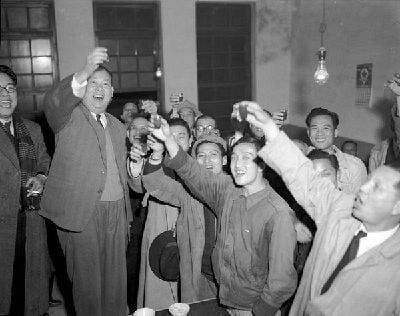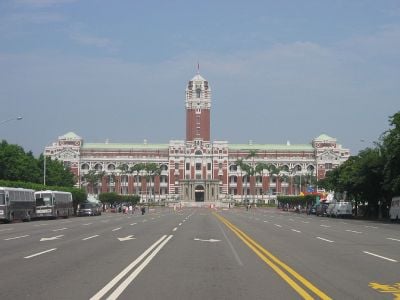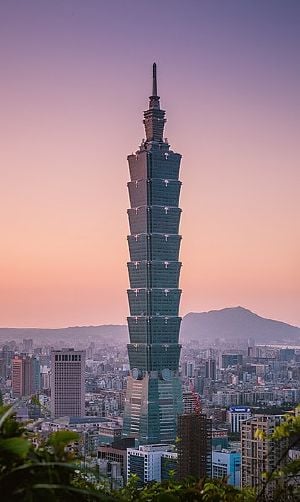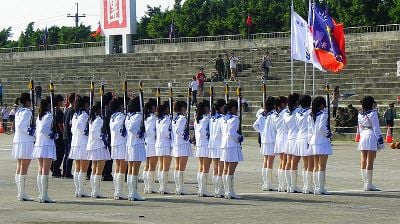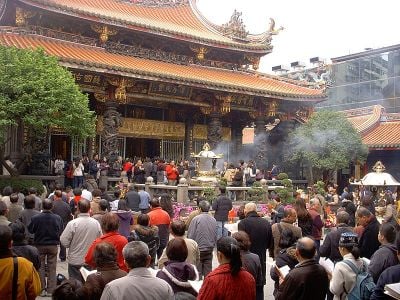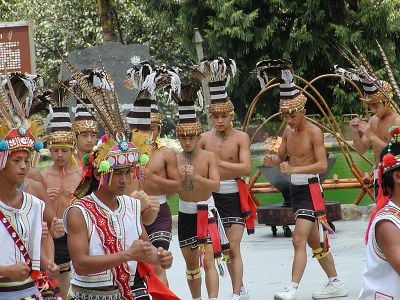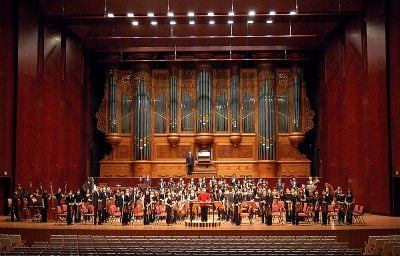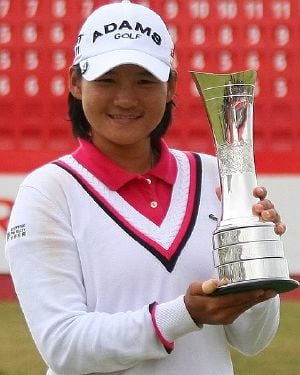- "Republic of China" redirects here.
Not to be confused with the People's Republic of China
For the civilization of China and its history see China
| Republic of China 中華民國 |
||||||
|---|---|---|---|---|---|---|
|
||||||
| Anthem: "National Anthem of the Republic of China" |
||||||
| Capital | Taipei[1] | |||||
| Largest subdivision | New Taipei | |||||
| National languages[5] | Formosan languages[2] Hakka[3] |
|||||
| Demonym | Taiwanese[6] | |||||
| Government | Unitary semi-presidential constitutional republic | |||||
| - | President | Lai Ching-te | ||||
| - | Vice President | Hsiao Bi-khim | ||||
| Legislature | Legislative Yuan | |||||
| Formation | ||||||
| - | Republic proclaimed | January 1, 1912 | ||||
| - | Taiwan transferred | October 25, 1945 | ||||
| - | Constitution adopted | December 25, 1947 | ||||
| - | Government moved to Taipei | December 7, 1949 | ||||
| Area | ||||||
| - | Total | 35,980 km2 [6] 13,892 sq mi |
||||
| Population | ||||||
| - | 2024 estimate | |||||
| - | 2010 census | 23,123,866[8] | ||||
| - | Density | 650/km2 (10th) 1,683.5/sq mi |
||||
| GDP (PPP) | 2023 estimate | |||||
| - | Total | |||||
| - | Per capita | |||||
| GDP (nominal) | 2023 estimate | |||||
| - | Total | |||||
| - | Per capita | |||||
| Gini (2022) | 34.2[10] | |||||
| Currency | New Taiwan dollar (NT$) (TWD) |
|||||
| Time zone | National Standard Time (UTC+8) | |||||
| Date formats | yyyy-mm-dd yyyy年m月d日 (CE; CE+2697) 民國yy年m月d日 (CE−1911) |
|||||
| Drives on the | Right | |||||
| Internet TLD | .tw .台灣 .台湾 |
|||||
| Calling code | +886 | |||||
Taiwan, officially the Republic of China (ROC), is a state in East Asia. Neighboring countries include the People's Republic of China (PRC) to the west, Japan to the north-east, and the Philippines to the south. The eastern two thirds of the island of Taiwan is dominated by mountain ranges while plains in the western third are where its highly urbanized population is concentrated. With over 20 million inhabitants, Taiwan is among the most densely populated states, and is the most populous state and largest economy that is not a member of the United Nations (UN).
Taiwanese indigenous peoples settled the island of Taiwan around 6,000 years ago. Dutch colonial rule opened the island to mass Han immigration, and the island was annexed in 1683 by the Qing dynasty of China, and ceded to the Empire of Japan in 1895. Following the surrender of Japan in 1945, the Republic of China took control of Taiwan. The resumption of the Chinese Civil War led to the loss of the mainland to the Communist Party of China and the flight of the ROC government to Taiwan in 1949. In the early 1960s, Taiwan entered a period of rapid economic growth and industrialization called the "Taiwan Miracle."
The ROC is no longer a member of the United Nations, having been replaced by the People's Republic of China (PRC) in 1971. Taiwan is claimed by the PRC, which refuses diplomatic relations with countries which recognize the ROC. International organizations in which the PRC participates either refuse to grant membership to Taiwan or allow it to participate only as a non-state actor, often under the name "Chinese Taipei." Domestically, the major political division is between parties favoring eventual Chinese unification and promoting a Chinese identity contrasted with those aspiring to independence and promoting Taiwanese identity. The status of Taiwan remains a contentious issue and its resolution is needed to ensure stable, peaceful relationships among East Asian nations and for the world as a whole.
Etymology
Various names for the island of Taiwan remain in use today, each derived from explorers or rulers during a particular historical period. The name Formosa (福爾摩沙) dates from 1542, when Portuguese sailors sighted an uncharted island and noted it on their maps as Ilha Formosa ("beautiful island").[11] The name Formosa eventually "replaced all others in European literature" and remained in common use among English speakers into the twentieth century.[12]
In the early seventeenth century, the Dutch East India Company established a commercial post at Fort Zeelandia (modern-day Anping, Tainan) on a coastal sandbar called "Tayouan," after their ethnonym for a nearby Taiwanese aboriginal tribe, possibly Taivoan people, written by the Dutch and Portuguese variously as Taiouwang, Tayowan, Teijoan, and so forth.[13] This name was also adopted into the Chinese vernacular (in particular, Hokkien, as the name of the sandbar and nearby area (Tainan). Use of the current Chinese name (臺灣) became official as early as 1684 with the establishment of Taiwan Prefecture. Through its rapid development the entire Formosan mainland eventually became known as "Taiwan."[11]
During the 1950s and 1960s, after the government had withdrawn to Taiwan upon losing the Chinese Civil War, it was commonly referred to as "Nationalist China" (or "Free China") to differentiate it from "Communist China" (or "Red China").[14]
It was a member of the United Nations representing "China" until 1971, when it lost its seat to the People's Republic of China. Over subsequent decades, the Republic of China has become commonly known as "Taiwan," after the island that comprises 99 percent of the territory under its control. In some contexts, especially ROC government publications, the name is written as "Republic of China (Taiwan)."[15]
The Republic of China participates in most international forums and organizations under the name "Chinese Taipei" due to diplomatic pressure from the People's Republic of China. For instance, it is the name under which it has competed at the Olympic Games since 1984,[16] and its name as an observer at the World Health Organization.[17]
Geography
Taiwan is an island state in East Asia. The main island, known historically as Formosa, makes up 99 percent of the area controlled by the ROC, measuring 35,808 square kilometers (13,826 sq mi) and lying some 180 kilometers (112 mi) across the Taiwan Strait from the southeastern coast of mainland China. The East China Sea lies to its north, the Philippine Sea to its east, the Luzon Strait directly to its south and the South China Sea to its southwest. Smaller islands include a number in the Taiwan Strait including the Penghu archipelago, the Kinmen and Matsu Islands near the Chinese coast, and some of the South China Sea Islands.
The main island is a tilted fault block, characterized by the contrast between the eastern two-thirds, consisting mostly of five rugged mountain ranges parallel to the east coast, and the flat to gently rolling plains of the western third, where the majority of Taiwan's population reside. There are several peaks over 3,500 m, the highest being Yu Shan at 3,952 meters (12,970 ft), making Taiwan the world's fourth-highest island. The tectonic boundary that formed these ranges is still active, and the island experiences many earthquakes, a few of them highly destructive. There are also many active submarine volcanoes in the Taiwan Straits.
The eastern mountains are heavily forested and home to a diverse range of wildlife, while land use in the western and northern lowlands is intensive.
Geology
The island of Taiwan lies in a complex tectonic area between the Yangtze Plate to the west and north, the Okinawa Plate on the north-east, and the Philippine Mobile Belt on the east and south. The upper part of the crust on the island is primarily made up of a series of terranes, mostly old island arcs which have been forced together by the collision of the forerunners of the Eurasian Plate and the Philippine Sea Plate. These have been further uplifted as a result of the detachment of a portion of the Eurasian Plate as it was subducted beneath remnants of the Philippine Sea Plate, a process which left the crust under Taiwan more buoyant.
The east and south of Taiwan are a complex system of belts formed by, and part of the zone of, active collision between the North Luzon Trough portion of the Luzon Volcanic Arc and South China, where accreted portions of the Luzon Arc and Luzon forearc form the eastern Coastal Range and parallel inland Longitudinal Valley of Taiwan respectively.[18]
Climate
Taiwan lies on the Tropic of Cancer, and its general climate is marine tropical.[6] The northern and central regions are subtropical, whereas the south is tropical and the mountainous regions are temperate.[19]
The average rainfall is 2,600 millimeters (100 in) per year for the island proper; with 2,200 millimeters (87 in) in the plains and more than 3,000 millimeters (120 in) in the mountains. The rainy season is concurrent with the onset of the summer East Asian Monsoon in May and June. The entire island experiences hot, humid weather from June through September. Typhoons are most common in July, August and September. During the winter (November to March), the northeast experiences steady rain, while the central and southern parts of the island are mostly sunny.[19]
History
Prehistory
Taiwan was joined to the mainland in the Late Pleistocene, until sea levels rose about 10,000 years ago. Fragmentary human remains dated 20,000 to 30,000 years ago have been found on the island, as well as later artifacts of a paleolithic culture.[20]
Around 6,000 years ago, Taiwan was settled by farmers, most likely from mainland China.[21] They are believed to be the ancestors of today's Taiwanese aborigines, whose languages belong to the Austronesian language family, but show much greater diversity than the rest of the family, which spans a huge area from Maritime Southeast Asia west to Madagascar and east as far as New Zealand, Hawaii, and Easter Island. This has led linguists to propose Taiwan as the urheimat, the area of origin, of the family, from which seafaring peoples dispersed across Southeast Asia and the Pacific and Indian Oceans.[22]
Han Chinese fishermen began settling in the Penghu islands in the thirteenth century.[23] Hostile tribes, and a lack of valuable trade products, meant that few outsiders visited the main island until the sixteenth century, when visits to the coast by fishermen and traders from Fujian, as well as Chinese and Japanese pirates, became more frequent.[23]
Seventeenth century
The Dutch East India Company attempted to establish a trading outpost on the Penghu Islands (Pescadores) in 1622, but were driven off by Ming forces.[24] In 1624, the company established a stronghold called Fort Zeelandia on the coastal islet of Tayouan, which is now part of the main island at Anping, Tainan. When the Dutch arrived, they found southwestern Taiwan already frequented by a mostly-transient Chinese population numbering close to 1,500.[25]
David Wright, a Scottish agent of the company who lived on the island in the 1650s, described the lowland areas of the island as being divided among 11 chiefdoms ranging in size from two settlements to 72. Some of these fell under Dutch control, while others remained independent.[26] The Company began to import laborers from Fujian and Penghu, many of whom settled.[24]
In 1626, the Spanish Empire landed on and occupied northern Taiwan, at the ports of Keelung and Tamsui, as a base to extend their trading. This colony lasted 16 years until 1642, when the last Spanish fortress fell to Dutch forces.
Following the fall of the Ming dynasty, Koxinga (Zheng Chenggong), a self-styled Ming loyalist, arrived on the island and captured Fort Zeelandia in 1662, expelling the Dutch Empire and military from the island. Koxinga established the Kingdom of Tungning (1662–1683), with his capital at Tainan. He and his heirs, Zheng Jing, who ruled from 1662 to 1682, and Zheng Keshuang, who ruled less than a year, continued to launch raids on the southeast coast of mainland China well into the Qing dynasty era.[24]
Qing rule
In 1683, following the defeat of Koxinga's grandson by an armada led by Admiral Shi Lang of southern Fujian, the Qing dynasty formally annexed Taiwan, placing it under the jurisdiction of Fujian province. The Qing imperial government tried to reduce piracy and vagrancy in the area, issuing a series of edicts to manage immigration and respect aboriginal land rights. Immigrants mostly from southern Fujian continued to enter Taiwan. The border between taxpaying lands and what was considered "savage" lands shifted eastward, with some aborigines becoming sinicized while others retreated into the mountains. During this time, there were a number of conflicts between different ethnic groups of Han Chinese, Quanzhou Minnanese feuding with Zhangzhou and Hakkas peasants, and major clan fights between Minnans (Hoklos), Hakkas, and aborigines.
Northern Taiwan and the Penghu Islands were the scene of subsidiary campaigns in the Sino-French War (August 1884 to April 1885). The French occupied Keelung on October 1, 1884, but were repulsed from Tamsui a few days later. The French won some tactical victories but were unable to exploit them, and the Keelung Campaign ended in stalemate. The Pescadores Campaign was a French victory, but had no long-term consequences. The French evacuated both Keelung and the Penghu archipelago after the end of the war in 1885.
In 1887, the Qing upgraded the island's administration from being the Taiwan Prefecture of Fujian Province to Fujian-Taiwan-Province, the twentieth in the empire, with its capital at Taipei. This was accompanied by a modernization drive that included building China's first railway.[12]
Japanese rule
As the Qing dynasty was defeated in the First Sino-Japanese War (1894–1895), Taiwan, along with Penghu and Liaodong Peninsula, were ceded in full sovereignty to the Empire of Japan by the Treaty of Shimonoseki. Inhabitants of Taiwan and Penghu wishing to remain Qing subjects were given a two-year grace period to sell their property and move to mainland China. On May 25, 1895, a group of pro-Qing high officials proclaimed the Republic of Formosa to resist impending Japanese rule. Japanese forces entered the capital at Tainan and quelled this resistance on October 21, 1895.[27] Several subsequent rebellions against the Japanese (the Beipu uprising of 1907, the Tapani incident of 1915, and the Musha incident of 1930) were all unsuccessful.
Japanese colonial rule was instrumental in the industrialization of the island, extending the railways and other transport networks, building an extensive sanitation system, and establishing a formal education system in Taiwan.[28] Japanese rule ended the practice of headhunting.[29] During this period the human and natural resources of Taiwan were used to aid the development of Japan and the production of cash crops such as rice and sugar greatly increased. Still, the Taiwanese and aborigines were classified as second- and third-class citizens. After suppressing Chinese guerrillas in the first decade of their rule, Japanese authorities engaged in a series of bloody campaigns against the mountain aboriginals, culminating in the Musha Incident of 1930.[30]
Around 1935, the Japanese began an island-wide assimilation project to bind the island more firmly to the Japanese Empire. Under the Kominka Movement people were taught to see themselves as Japanese, during which time Taiwanese culture and religion were outlawed and the citizens were encouraged to adopt Japanese surnames.[31]
Taiwan held strategic wartime importance as Imperial Japanese military campaigns first expanded and then contracted over the course of World War II. The "South Strike Group" was based at the Taihoku Imperial University in Taipei. The Imperial Japanese Navy operated heavily out of Taiwanese ports. In October 1944 the Formosa Air Battle was fought between American carriers and Japanese forces based in Taiwan. Important Japanese military bases and industrial centers throughout Taiwan, such as Kaohsiung and Keelung, were targets of heavy raids by American bombers.[32]
After Japan's surrender ended World War II, most of Taiwan's approximately 300,000 Japanese residents were expelled and sent to Japan.
Republic of China rule
On January 1, 1912, while Taiwan was still under Japanese rule, the Republic of China (ROC) was founded on the mainland, following the Xinhai Revolution, which began with the Wuchang Uprising on October 10, 1911, replacing the Qing Dynasty and ending over two thousand years of imperial rule in China.[33] From its founding until 1949 the ROC was based in mainland China. Central authority waxed and waned in response to warlordism (1915–1928), Japanese invasion (1937–1945), and the Chinese Civil War (1927–1950), with central authority strongest during the Nanjing decade (1927–1937), when most of China came under the control of the Kuomintang (KMT) under an authoritarian one-party state.[34]
After the Surrender of Japan on October 25, 1945, the US Navy ferried ROC troops to Taiwan in order to accept the formal surrender of Japanese military forces in Taipei on behalf of the Allied Powers, as part of General Order No. 1 for temporary military occupation. General Rikichi Andō, governor-general of Taiwan and commander-in-chief of all Japanese forces on the island, signed the receipt and handed it over to General Chen Yi of the ROC military to complete the official turnover. Chen Yi proclaimed that day to be "Taiwan Retrocession Day," but the Allies considered Taiwan and the Penghu Islands to be under military occupation and still under Japanese sovereignty until 1952, when the Treaty of San Francisco, also called the Treaty of Peace with Japan, took effect.
The ROC administration of Taiwan under Chen Yi was strained by increasing tensions between Taiwanese-born people and newly arrived mainlanders, which were compounded by economic woes, such as hyperinflation. Furthermore, cultural and linguistic conflicts between the two groups quickly led to the loss of popular support for the new government, while the mass movement led by the working committee of the Communist Party also aimed to bring down the Kuomintang government.[35] The shooting of a civilian on February 28, 1947 triggered island-wide unrest, which was suppressed with military force in what is now called the February 28 Incident. Mainstream estimates of the number killed range from 18,000 to 30,000. Those killed were mainly members of the Taiwanese elite.[36]
After the end of World War II, the Chinese Civil War resumed between the Chinese Nationalists (Kuomintang), led by Chiang Kai-shek, and the Communist Party of China, led by Mao Zedong. Throughout the months of 1949, a series of Chinese Communist offensives led to the capture of its capital Nanjing on April 23 and the subsequent defeat of the Nationalist army on the mainland. The Communists founded the People's Republic of China on October 1.[37]
On December 7, 1949, after the loss of four capitals, Chiang evacuated his Nationalist government to Taiwan and made Taipei the temporary capital of the ROC. More than 1.5 million people, consisting mainly of soldiers, members of the ruling Kuomintang and intellectual and business elites, were evacuated from mainland China to Taiwan at that time, adding to the earlier population of approximately six million. In addition, the ROC government took to Taipei many national treasures and much of China's gold reserves and foreign currency reserves.[38][39]
After losing most of the mainland, the Kuomintang remained in control of Tibet, portions of Qinghai, Xinjiang, and Yunnan provinces along with Hainan Island until 1951 when the Communists subsequently captured these territories too. From this point onward, the Kuomintang's territory was reduced to the island of Taiwan, Penghu, Kinmen, and Matsu Islands (Fujian Province), and two major islands of the Dongsha and Nansha island groups. The Kuomintang continued to claim sovereignty over all of "China," which it defined to include mainland China, Taiwan, Outer Mongolia, and other areas. On mainland China, the victorious Communists claimed they ruled the sole and only China (which they claimed included Taiwan) and that the Republic of China no longer existed.[40]
Chinese Nationalist rule
Initially, the United States abandoned the KMT and expected that Taiwan would fall to the Communists. However, in 1950 the conflict between North Korea and South Korea, which had been ongoing since the Japanese withdrawal in 1945, escalated into full-blown war, and in the context of the Cold War, US President Harry S. Truman intervened again and dispatched the US Navy's 7th Fleet into the Taiwan Strait to prevent hostilities between Taiwan and mainland China. In the Treaty of San Francisco and the Treaty of Taipei, which came into force respectively on April 28, 1952 and August 5, 1952, Japan formally renounced all right, claim and title to Taiwan and Penghu, and renounced all treaties signed with China before 1942. Neither treaty specified to whom sovereignty over the islands should be transferred, because the United States and the United Kingdom disagreed on whether the ROC or the PRC was the legitimate government of China.[41] Continuing conflict of the Chinese Civil War through the 1950s, and intervention by the United States notably resulted in legislation such as the Sino-American Mutual Defense Treaty and the Formosa Resolution of 1955.
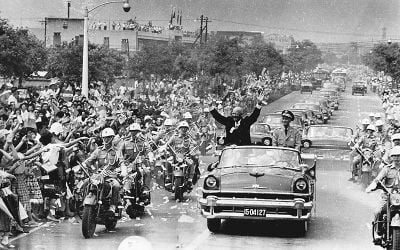
As the Chinese Civil War continued without truce, the government built up military fortifications throughout Taiwan. Within this effort, KMT veterans built the now famous Central Cross-Island Highway through the Taroko Gorge in the 1950s. The two sides would continue to engage in sporadic military clashes with seldom publicized details well into the 1960s on the China coastal islands with an unknown number of night raids. During the Second Taiwan Strait Crisis in September 1958, Taiwan's landscape saw Nike-Hercules missile batteries added, with the formation of the 1st Missile Battalion Chinese Army that would not be deactivated until 1997. Newer generations of missile batteries have since replaced the Nike Hercules systems throughout the island.
Martial law, declared on Taiwan in May 1949, continued to be in effect after the central government relocated to Taiwan. During the 1960s and 1970s, the ROC maintained an authoritarian, single-party government while its economy became industrialized and technology-oriented. This rapid economic growth, known as the "Taiwan Miracle," was the result of a fiscal regime independent from mainland China and backed up, among others, by the support of US funds and demand for Taiwanese products.[42] In the 1970s, Taiwan was economically the second fastest growing state in Asia after Japan. Along with Hong Kong, South Korea, and Singapore, Taiwan became known as one of the "Four Asian Tigers."
Martial law was not repealed until 1987, and was used as a way to suppress political opposition in the intervening years.[43] During the White Terror, as this period is known, 140,000 people were imprisoned or executed for being perceived as anti-KMT or pro-Communist. Many citizens were arrested, tortured, imprisoned, and executed for their real or perceived link to the Communists. Since these people were mainly from the intellectual and social elite, an entire generation of political and social leaders was decimated. In 1998, a law was passed to create the "Compensation Foundation for Improper Verdicts" which oversaw compensation to White Terror victims and families. President Ma Ying-jeou made an official apology in 2008, expressing hope that there would never again be a tragedy similar to White Terror.[44]
Until the 1970s the government was regarded by Western critics as undemocratic for upholding martial law, for severely repressing any political opposition, and for controlling media. The KMT did not allow the creation of new parties and those that existed did not seriously compete with the KMT. Thus, competitive democratic elections did not exist.[45][46][47] From the late 1970s to the 1990s, however, Taiwan went through reforms and social changes that transformed it from an authoritarian state to a democracy. In 1979, a pro-democracy protest took place in Kaohsiung to celebrate Human Rights Day. Although the protest was rapidly crushed by the authorities, it is today considered as the main event that united Taiwan's opposition.[48]
Democratic reforms
Chiang Ching-kuo, Chiang Kai-shek's son and successor as the president, began reforms to the political system in the mid-1980s. In 1984, the younger Chiang selected Lee Teng-hui, a Taiwanese-born, US-educated technocrat, to be his vice-president. In 1986, the Democratic Progressive Party (DPP) was formed and inaugurated as the first opposition party in the ROC to counter the KMT. A year later, Chiang Ching-kuo lifted martial law on the main island of Taiwan (martial law was lifted on Penghu in 1979, Matsu island in 1992, and Kinmen island in 1993). With the advent of democratization, the issue of the political status of Taiwan gradually resurfaced as a controversial issue where, previously, the discussion of anything other than unification under the ROC was taboo.
After the death of Chiang Ching-kuo in January 1988, Lee Teng-hui succeeded him and became the first Taiwan-born president. Lee continued the democratic reforms to the government and decreased the concentration of government authority in the hands of mainland Chinese. Under Lee, Taiwan underwent a process of localization in which Taiwanese culture and history were promoted over a pan-China viewpoint in contrast to earlier KMT policies which had promoted a Chinese identity. Lee's reforms included printing banknotes from the Central Bank rather than the Provincial Bank of Taiwan, and streamlining the Taiwan Provincial Government with most of its functions transferred to the Executive Yuan. Under Lee, the original members of the Legislative Yuan and National Assembly (a former supreme legislative body defunct in 2005), elected in 1947 to represent mainland Chinese constituencies and having held the seats without re-election for more than four decades, were forced to resign in 1991. The previously nominal representation in the Legislative Yuan was brought to an end, reflecting the reality that the ROC had no jurisdiction over mainland China, and vice versa. Restrictions on the use of Taiwanese Hokkien in the broadcast media and in schools were also lifted.[49]
Democratic reforms continued in the 1990s, with Lee Teng-hui re-elected in 1996, in the first direct presidential election in the history of the ROC.[50] In 2000, Chen Shui-bian of the Democratic Progressive Party was elected as the first non-Kuomintang (KMT) President.
On September 30, 2007, the ruling DPP approved a resolution asserting a separate identity from China and called for the enactment of a new constitution for a "normal country." It also called for general use of "Taiwan" as its name, without abolishing its formal name, the Republic of China.[51]
The KMT increased its majority in the Legislative Yuan in the January 2008 legislative elections, while its nominee Ma Ying-jeou went on to win the presidency in March of the same year, campaigning on a platform of increased economic growth and better ties with the PRC under a policy of "mutual nondenial."
In 2016, Tsai Ing-wen of the Democratic Progressive Party (DPP) became President of Taiwan. President Tsai called upon the international community to help Taiwan to preserve its democracy despite the threatening language used against Taiwan by Xi Jinping, General Secretary of the Communist Party of China (PRC paramount leader): "President Xi said on Wednesday that China reserves the right to use force to bring Taiwan under its control."[52] President Tsai called upon the PRC to democratize, respect human rights, and renounce the use of military force against Taiwan.[53]
Political and legal status
The political and legal statuses of Taiwan are contentious issues. The People's Republic of China (PRC) claims that the Republic of China government is illegitimate, referring to it as the "Taiwan Authorities:"
Since the KMT ruling clique retreated to Taiwan, although its regime has continued to use the designations "Republic of China" and "government of the Republic of China," it has long since completely forfeited its right to exercise state sovereignty on behalf of mainland China and, in reality, has always remained only a separate state on the island of Taiwan."[40]
Taiwan's leaders, on the other hand, argue that it is a sovereign state. The ROC has its own constitution, independently elected president and armed forces. It has not formally renounced its claim to the mainland, but ROC government publications have increasingly downplayed it.[54]
The PRC views the island as a renegade province and vows to eventually “unify” Taiwan with the mainland. In Taiwan, which has its own democratically elected government and is home to twenty-three million people, political leaders have differing views on the island’s status and relations with the mainland.[55]
Internationally, there is controversy on whether the ROC still exists as a state or a defunct state per international law due to the lack of wide diplomatic recognition.
Relations with the PRC
The PRC supports a version of the One-China policy, which states that Taiwan and mainland China are both part of China, and that the PRC is the only legitimate government of China. It uses this policy to prevent the international recognition of the ROC as an independent sovereign state, meaning that Taiwan participates in international forums under the name "Chinese Taipei." With the emergence of the Taiwanese independence movement, the name "Taiwan" has been used increasingly often on the island.[56]
The political environment is complicated by the potential for military conflict should Taiwan declare de jure independence. It is the official PRC policy to force unification if peaceful unification is no longer possible, as stated in its anti-secession law, and for this reason there is a substantial military presence on the Fujian coast.[57]
On April 29, 2005, the first meeting between the leaders of the two parties since the end of the Chinese Civil War in 1949 took place when Kuomintang Chairman Lien Chan traveled to Beijing and met with Communist Party of China (CPC) General Secretary Hu Jintao.[58]
On November 7, 2015, Ma Ying-jeou (in his capacity as Leader of Taiwan) and Xi Jinping (in his capacity as paramount leader of the PRC) traveled to Singapore for the highest level meeting between Taiwan and the PRC in 66 years.[59]
In response to US support for Taiwan, the Chinese defence ministry declared in 2019 that "If anyone dares to split Taiwan from China, the Chinese military has no choice but to fight at all costs."[60]
Foreign relations
After the KMT's retreat to Taiwan, most countries, notably the countries in the Western Bloc, continued to maintain relations with the ROC. Due to diplomatic pressure, recognition gradually eroded and in the 1970s many countries switched recognition to the PRC. UN Resolution 2758 (October 25, 1971) recognized the People's Republic of China as China's sole representative in the United Nations.[61]
The PRC refuses to have diplomatic relations with any nation that has diplomatic relations with the ROC, and requires all nations with which it has diplomatic relations to make a statement recognizing its claims to Taiwan.[62] As a result, only a few UN member states and the Holy See maintain official diplomatic relations with the Republic of China. The ROC maintains unofficial relations with most countries via de facto embassies and consulates called Taipei Economic and Cultural Representative Offices (TECRO), with branch offices called "Taipei Economic and Cultural Offices" (TECO). Both TECRO and TECO are "unofficial commercial entities" of the ROC in charge of maintaining diplomatic relations, providing consular services (such as visa applications), and serving the national interests of the ROC in other countries.[63]
The United States remains one of the main allies of Taiwan and, through the Taiwan Relations Act passed in 1979, has continued selling arms and providing military training to the Armed Forces.[64] This situation continues to be an issue for the People's Republic of China which considers US involvement disruptive to the stability of the region.
The official position of the United States is that the PRC is expected to "use no force or threat[en] to use force against Taiwan" and the ROC is to "exercise prudence in managing all aspects of Cross-Strait relations." Both are to refrain from performing actions or espousing statements "that would unilaterally alter Taiwan's status."[65]
International participation
The ROC was a founding member of the United Nations, and held the seat of China on the Security Council and other UN bodies until 1971, when it was expelled by Resolution 2758 and replaced in all UN organs with the PRC. Each year since 1992, the ROC has petitioned the UN for entry, but its applications have not made it past committee stage.[66]
Due to its limited international recognition, the Republic of China has been a member of the Unrepresented Nations and Peoples Organization (UNPO) since the foundation of the organization in 1991, under the name "Taiwan."[67]
Also due to its One China policy, the PRC only participates in international organizations where the ROC does not participate as a sovereign country. Most member states, including the United States, do not wish to discuss the issue of the ROC's political status for fear of souring diplomatic ties with the PRC.[68] However, both the US and Japan publicly supported the ROC's bid for membership in the World Health Organization as an observer.[69]
Due to PRC pressure, the ROC is forced to use the name "Chinese Taipei" in international events, such as the Olympic Games, where the PRC is also a party. The ROC is typically barred from using its national anthem and national flag in international events due to PRC pressure; ROC spectators attending events such as the Olympics are often barred from bringing ROC flags into venues.[70] Taiwan also participates in the Asia-Pacific Economic Cooperation forum (since 1991) and the World Trade Organization (since 2002) under the name "Chinese Taipei."
The ROC is able to participate as "China" in organizations that the PRC does not participate in, such as the World Organization of the Scout Movement.
National identity
Over 80 percent of Taiwan's population descends from Han Chinese, who migrated from Qing China between 1661 and 1895. Another significant group descends from Han Chinese who immigrated from mainland China in the late 1940s and early 1950s. The shared cultural origin combined with several hundred years of geographical separation, some hundred years of political separation and foreign influences, as well as hostility between the rival ROC and PRC have resulted in national identity being a contentious issue with political overtones.
Since democratic reforms and the lifting of martial law, a distinct Taiwanese identity (as opposed to Taiwanese identity as a subset of a Chinese identity) is often at the heart of political debates. Its acceptance makes the island distinct from mainland China, and therefore may be seen as a step towards forming a consensus for de jure Taiwan independence.[71] The pan-green camp supports a distinct Taiwanese identity, while the pan-blue camp supports a Chinese identity only.[72]
Government and politics
The government of the Republic of China was founded on the Constitution of the ROC and its Three Principles of the People, which states that the ROC "shall be a democratic republic of the people, to be governed by the people and for the people."[19]
The constitution was drafted before the fall of mainland China to the Communist Party of China. It was created by the KMT for the purpose of all of its claimed territory, including Taiwan, even though the Communist Party boycotted the drafting of the constitution. The constitution went into effect on December 25, 1947.[73] The ROC remained under martial law from 1948 until 1987 and much of the constitution was not in effect. Political reforms beginning in the late 1970s and continuing through the early 1990s transformed into a multiparty democracy. Since the lifting of martial law, the Republic of China has democratized and reformed, suspending constitutional components that were originally meant for the whole of China. This process of amendment continues. In 2000, the Democratic Progressive Party (DPP) won the presidency, ending KMT's continuous control of the government. In May 2005, a new National Assembly was elected to reduce the number of parliamentary seats and implement several constitutional reforms. These reforms passed; the National Assembly essentially voted to abolish itself and transfer the power of constitutional reform to the popular ballot.[74]
The government is divided into five branches (Yuan): the Executive Yuan (cabinet), the Legislative Yuan (Congress or Parliament), the Judicial Yuan, the Control Yuan (audit agency), and the Examination Yuan (civil service examination agency).
The head of state and commander-in-chief of the armed forces is the president, who is elected by popular vote for a maximum of 2 four-year terms on the same ticket as the vice-president. The president has authority over the Yuan. The president appoints the members of the Executive Yuan as his cabinet, including a premier, who is officially the President of the Executive Yuan; members are responsible for policy and administration.[19]
The main legislative body is the unicameral Legislative Yuan with 113 seats. Seventy-three are elected by popular vote from single-member constituencies; thirty-four are elected based on the proportion of nationwide votes received by participating political parties in a separate party list ballot; and six are elected from two three-member aboriginal constituencies. Members serve four-year terms. Originally the unicameral National Assembly, as a standing constitutional convention and electoral college, held some parliamentary functions, but the National Assembly was abolished in 2005 with the power of constitutional amendments handed over to the Legislative Yuan and all eligible voters of the Republic via referendums.[19]
The premier is selected by the president without the need for approval from the legislature, but the legislature can pass laws without regard for the president, as neither he nor the Premier wields veto power.[19] Thus, there is little incentive for the president and the legislature to negotiate on legislation if they are of opposing parties. Historically, the ROC has been dominated by strongman single party politics. This legacy has resulted in executive powers currently being concentrated in the office of the president rather than the premier, even though the constitution does not explicitly state the extent of the president's executive power.[75]
The Judicial Yuan is the highest judicial organ. It interprets the constitution and other laws and decrees, judges administrative suits, and disciplines public functionaries. The president and vice-president of the Judicial Yuan and additional thirteen justices form the Council of Grand Justices. They are nominated and appointed by the president, with the consent of the Legislative Yuan. The highest court, the Supreme Court, consists of a number of civil and criminal divisions, each of which is formed by a presiding judge and four associate judges, all appointed for life. In 1993, a separate constitutional court was established to resolve constitutional disputes, regulate the activities of political parties and accelerate the democratization process. There is no trial by jury but the right to a fair public trial is protected by law and respected in practice; many cases are presided over by multiple judges.[19]
The Control Yuan is a watchdog agency that monitors (controls) the actions of the executive. It can be considered a standing commission for administrative inquiry and can be compared to the Court of Auditors of the European Union or the Government Accountability Office of the United States.
The Examination Yuan is in charge of validating the qualification of civil servants. It is based on the old imperial examination system used in dynastic China. It can be compared to the European Personnel Selection Office of the European Union or the Office of Personnel Management of the United States.
Administrative divisions
Taiwan is divided into 22 subnational divisions, each with a local government led by an elected head and a local council. Local governments are responsible or partially responsible for social services, education, urban planning, public construction, water management, environmental protection, transport, and public safety.
There are three types of subnational divisions: special municipalities, cities and counties. Special municipalities and cities are further divided into districts for local administration. Counties are further divided into townships and county-administered cities which have government offices with elected leaders and local councils, which share responsibilities with the county. Some divisions are indigenous divisions which have different degrees of autonomy to standard ones. In addition, districts, cities, and townships are further divided into villages and neighborhoods.
Major camps
The tension between mainland China and Taiwan shades most of political life since it is the official policy of the PRC to meet any Taiwanese government move towards "Taiwan independence" with a threat of invasion.[76] The PRC's official policy is to reunify Taiwan and mainland China under the formula of "one country, two systems" and refuses to renounce the use of military force, especially should Taiwan seek a declaration of independence.
Within Taiwan, opinions are polarized on how Taiwan should relate to China or the PRC, referred to as cross-Strait relations, between those supporting unification, represented by the Pan-Blue Coalition of parties, and those supporting independence, represented by the Pan-Green Coalition.
The Pan-Blue Coalition is composed of the pro-unification Kuomintang, People First Party (PFP), and New Party, who believe that the ROC is the sole legitimate government of "China" (including Taiwan) and supports eventual Chinese reunification. Pan-Blue members generally support the concept of the One-China policy, which states that there is only one China and that its only government is the ROC. They favor eventual re-unification of China.[72] The more mainstream Pan-Blue position is to lift investment restrictions and pursue negotiations with the PRC to immediately open direct transportation links. Regarding independence, the mainstream Pan-Blue position is to maintain the status quo, while refusing immediate reunification.[77]
The Pan-Green Coalition is composed of the pro-independence DPP and Taiwan Solidarity Union (TSU). It regards Taiwan as an independent, sovereign state synonymous with the ROC, opposes the definition that Taiwan is part of "China," and seeks wide diplomatic recognition and an eventual declaration of formal Taiwan independence. The Pan-Green camp tends to favor emphasizing the Republic of China as being a distinct country from the People's Republic of China. Thus, in September 2007, the then ruling Democratic Progressive Party approved a resolution asserting separate identity from China and called for the enactment of a new constitution for a "normal country." It called also for general use of "Taiwan" as its name, without abolishing its formal name, the "Republic of China."[78]
The KMT, the largest Pan-Blue party, supports the status quo for the indefinite future with a stated ultimate goal of unification. However, it does not support unification in the short term with the PRC as such a prospect would be unacceptable to most of its members and the public.[77]
The Democratic Progressive Party, the largest Pan-Green party, officially seeks independence, but in practice also supports the status quo because its members and the public would not accept the risk of provoking the PRC.[79]
Military

The Republic of China Army has its roots in the National Revolutionary Army, which was established by Sun Yat-sen in 1925 with a goal of reunifying China under the Kuomintang. When the People's Liberation Army (PLA) won the Chinese Civil War, much of the National Revolutionary Army retreated to Taiwan along with the government, where it was reformed into the Republic of China Army. Units which surrendered and remained in mainland China were either disbanded or incorporated into the PLA.
Today, Taiwan maintains a large and technologically advanced military, mainly as a defense against the constant threat of invasion by mainland China's PLA using the Anti-Secession Law of the People's Republic of China as a pretext. This law authorizes the use of military force when certain conditions are met.[80]
Control of the armed forces has also passed into the hands of the civilian government.[81] As the ROC military shares historical roots with the KMT, the older generation of high-ranking officers tends to have Pan-Blue sympathies. However, many have retired and there are many more non-mainlanders enlisting in the armed forces in the younger generations, so the political leanings of the military have moved closer to the public norm in Taiwan.[82]
Economy
Taiwan is well developed; its export-oriented industrial economy is the 21st-largest in the world, with major contributions from steel, machinery, electronics and chemicals manufacturing. The quick industrialization and rapid growth of Taiwan during the latter half of the twentieth century has been called the "Taiwan Miracle." Taiwan is one of the "Four Asian Tigers" alongside Hong Kong, South Korea, and Singapore.
In 1950, with the outbreak of the Korean War, the United States began an aid program which resulted in fully stabilized prices by 1952. Economic development was encouraged by American economic aid and programs such as the Joint Commission on Rural Reconstruction, which turned the agricultural sector into the basis for later growth. Under the combined stimulus of the land reform and the agricultural development programs, agricultural production increased at an average annual rate of 4 percent from 1952 to 1959, which was greater than the population growth.[83]
In 1974, Chiang Ching-kuo implemented the Ten Major Construction Projects, the beginning foundations that helped Taiwan transform into its current export driven economy. Since the 1990s, a number of Taiwan-based technology firms have expanded their reach around the world. Well-known international technology companies headquartered in Taiwan include personal computer manufacturers Acer Inc. and Asus, mobile phone maker HTC, as well as electronics manufacturing giant Foxconn, which makes products for Apple, Amazon, and Microsoft.
Since the beginning of the 1990s, the economic ties between Taiwan and the People's Republic of China have been very prolific. [84] Although the economy of Taiwan benefits from this situation, some have expressed the view that the island has become increasingly dependent on the mainland Chinese economy. A 2008 white paper by the Department of Industrial Technology stated that "Taiwan should seek to maintain stable relation with China while continuing to protect national security, and avoiding excessive 'Sinicization' of Taiwanese economy."[85] Others argue that close economic ties between Taiwan and mainland China would make any military intervention by the People's Liberation Army (PLA) against Taiwan very costly, and therefore less probable.[86]
Agriculture has been reduced to a very small proportion of the Taiwanese economy. Traditional labor-intensive industries are steadily being moved offshore and with more capital and technology-intensive industries replacing them. High-technology industrial parks have sprung up in every region. The ROC has become a major foreign investor in the PRC, Thailand, Indonesia, the Philippines, Malaysia, and Vietnam.
Today Taiwan has a dynamic, capitalist, export-driven economy with gradually decreasing state involvement in investment and foreign trade. In keeping with this trend, some large government-owned banks and industrial firms are being privatized.[87]
The ROC has been a member of governmental trade organizations such as the World Trade Organization under the name Separate Customs Territory of Taiwan, Penghu, Kinmen and Matsu (Chinese Taipei) since 2002.[88]
Transport
The Ministry of Transportation and Communications of the Republic of China is the cabinet-level governing body of the transport network in Taiwan.
Civilian transport in Taiwan is characterized by extensive use of scooters.
Both highways and railways are concentrated near the coasts where the majority of the population resides, with 1,619 km (1,006 mi) of motorway.
Railways in Taiwan are primarily used for passenger services, with Taiwan Railway Administration (TRA) operating a circular route and Taiwan High Speed Rail (THSR) running high speed services on the west coast. Urban transit systems include Taipei Metro, Kaohsiung Rapid Transit Taoyuan Metro and New Taipei Metro.
Major airports include Taiwan Taoyuan, Kaohsiung, Taipei Songshan and Taichung. There are currently seven airlines in Taiwan, the largest ones being China Airlines and EVA Air.
There are four international seaports: Keelung, Kaohsiung, Taichung, and Hualien.
Education
Taiwan is well known for adhering to the Confucian paradigm of valuing education as a means to improve one's socioeconomic position in society. Heavy investment and a cultural valuing of education has catapulted the resource-poor nation consistently to the top of global education rankings in reading literacy, mathematics, and sciences. The strong scholastic and educational performance of Taiwanese students has prompted the nation to build a highly educated labor force that possesses a strong background in mathematics and science to cope with the labor market demands of the twenty-first century.[89]
Many Taiwanese students attend cram schools, or bushiban, to improve skills and knowledge on problem solving against exams of subjects like mathematics, nature science, history and many others. Courses are available for most popular subjects and include lectures, reviews, private tutorial sessions, and recitations.[90]
Demographics
The majority of Taiwan's population of over 23 million live on the island proper. The remainder live on Penghu, Kinmen, and Matsu.
Ethnic groups
The ROC government reports that over 95 percent of the population is Han Chinese, of which the majority includes descendants of early Han Chinese immigrants who arrived in Taiwan in large numbers starting in the eighteenth century.
The Hoklo people are the largest Han subgroup (70 percent of the total population), whose ancestors migrated from the coastal southern Fujian region across the Taiwan Strait starting in the seventeenth century. The Hakka comprise about 15 percent of the total population, and descend from Han migrants to Guangdong, its surrounding areas and Taiwan. Additional people of Han origin include and descend from the 2 million Nationalists who fled to Taiwan following the communist victory on the mainland in 1949.[6]
The indigenous Taiwanese aborigines number about half a million and are divided into 16 groups.[91] The Ami, Atayal, Bunun, Kanakanavu, Kavalan, Paiwan, Puyuma, Rukai, Saisiyat, Saaroa, Sakizaya, Sediq, Thao, Truku, and Tsou live mostly in the eastern half of the island, while the Yami (also known as the Tao people) inhabit Orchid Island.[92]
Languages
Taiwan is officially multilingual. The languages of Taiwan consist of several varieties of languages under the families of Austronesian languages and Sino-Tibetan languages.
Mandarin, known as Guoyu ("national language") in Taiwan, is the primary language used in business and education, and is spoken by the vast majority of the population. Traditional Chinese is used as the writing system.[93] Although Mandarin is the language of instruction in schools and dominates television and radio, non-Mandarin Chinese varieties have undergone a revival in public life in Taiwan, particularly since restrictions on their use were lifted in the 1990s.[93] Some 70 percent of the population belong to the Hoklo ethnic subgroup, who descended from immigrants from southern Fujian during the Qing dynasty. They speak a Taiwanese form of Hokkien natively in addition to Mandarin.
The Formosan languages, a branch of Austronesian languages, have been spoken by the Taiwanese aborigines for thousands of years. They are written in Latin alphabet.[94] Their use among aboriginal minority groups declined as usage of Mandarin rose.[93] Of the 14 extant languages, five are considered moribund.[95]
Religion
The Constitution of the Republic of China protects people's freedom of religion and the practices of belief.[96]
The five largest religions are: Buddhism, Taoism, Folk religions (which includes folk religious movements of salvation such as Yiguandao), Protestantism, and Roman Catholicism. Taiwanese aborigines, who traditionally practiced an animistic religion, comprise a notable subgroup among professing Christians. When the island fell under Dutch rule in 1624, they were introduced to Protestantism, and two years later, with the transition to Spanish rule, the Catholic Church was introduced into the island.
There has been a small Muslim community of Hui people in Taiwan since the seventeenth century.[97]
Confucianism is a philosophy that deals with secular moral ethics, and serves as the foundation of both Chinese and Taiwanese culture. The majority of Taiwanese people usually combine the secular moral teachings of Confucianism with whatever religions they are affiliated with.
Culture
Over one hundred years of political separation from mainland China has led to distinct traditions in many areas, including cuisine and music. Today, the culture of Taiwan is a hybrid blend of various sources, incorporating elements of traditional Chinese culture, attributable to the historical and ancestral origin of the majority of its current residents, Japanese culture, traditional Confucianist beliefs, and increasingly Western values.
One of Taiwan's greatest attractions is the National Palace Museum, which houses more than 650,000 pieces of Chinese bronze, jade, calligraphy, painting, and porcelain and is considered one of the greatest collections of Chinese art and objects in the world.[98] The KMT moved this collection from the Forbidden City in Beijing in 1933 and part of the collection was eventually transported to Taiwan during the Chinese Civil War. The collection, estimated to be one-tenth of China's cultural treasures, is so extensive that only 1 percent is on display at any time. The PRC had said that the collection was stolen and has called for its return, but the ROC has long defended its control of the collection as a necessary act to protect the pieces from destruction, especially during the Cultural Revolution. Relations regarding this treasure have warmed in recent years.[99]
The classical music culture in Taiwan is highly developed and features artists such as violinist Cho-Liang Lin, pianist Ching-Yun Hu, and the Lincoln Center Chamber Music Society Artist Director Wu Han. Karaoke, drawn from contemporary Japanese culture, is extremely popular in Taiwan, where it is known as KTV. KTV businesses operate in a hotel-like style, renting out small rooms and ballrooms according to the number of guests in a group. Many KTV establishments partner with restaurants and buffets to form all-encompassing and elaborate evening affairs for families, friends, or businessmen. Tour buses that travel around Taiwan have several TV's, equipped not for watching movies, but primarily for singing Karaoke.
Taiwan has a high density of 24-hour convenience stores, which, due to the intense competition, have developed into "hybrid stores" or "shop-in-shops" by cooperating with a variety of known brands to offer products attractive to potential customers.[100]
Taiwanese culture has also influenced other cultures. Bubble tea and milk tea are available in Singapore, Malaysia, the Philippines, Australia, Europe, and North America. Taiwanese television shows are popular in Singapore, Malaysia, and other Asian countries. Taiwanese films have won various international awards at film festivals around the world. Ang Lee, a Taiwanese director, has directed critically acclaimed films such as: Crouching Tiger, Hidden Dragon, Brokeback Mountain, and Life of Pi.
Sports
Taiwan participates in international sporting organizations and events under the name of "Chinese Taipei" due to its political status. In 2009, Taiwan hosted two international sporting events on the island: The World Games 2009 were held in Kaohsiung in July, and Taipei hosted the 21st Summer Deaflympics in September of the same year. Furthermore, Taipei hosted the Summer Universiade in 2017.
Taiwan has a long history of strong international presence in table tennis. Chen Pao-pei was a gold medalist in the women's singles at the Asian Table Tennis Championships in 1953 and gold medalist with Chiang Tsai-yun in the 1957 women's doubles and women's team events. Lee Kuo-ting won the men's singles at the 1958 Asian Table Tennis Championships. More recently Chen Chien-an won the 2008 World Junior Table Tennis Championships in singles and pairing with Chuang Chih-yuan won the men's doubles in 2013 at the 52nd World Table Tennis Championships.[101] Playing for Taiwan Chen Jing won a bronze medal at the 1996 Olympic Games and a silver medal at in 2000, while Cheng I-ching and Lin Yun-ju won a bronze medal at the 2020 games.[102] 17 year old Lin Yun-Ju upset both reigning world champion Ma Long and world ranked #3 Fan Zhendong to win the 2019 men's singles in the T2 Diamond Series in Malaysia.
Baseball is Taiwan's national sport and a popular spectator sport. The Chinese Professional Baseball League (CPBL) was established in Taiwan in 1989, and eventually absorbed the competing Taiwan Major League in 2003.
Taekwondo has become a mature and successful sport in Taiwan in recent years. In the 2004 Olympics, Chen Shih-hsin and Chu Mu-yen won the first two gold medals in women's flyweight event and men's flyweight event, respectively. Subsequent taekwondo competitors such as Yang Shu-chun have strengthened Taiwan's taekwondo culture.
Yani Tseng is the most famous Taiwanese professional golfer currently playing on the US-based LPGA Tour. She is the youngest player ever, male or female, to win five major championships and was ranked number 1 in the Women's World Golf Rankings for 109 consecutive weeks from 2011 to 2013.[103]
Taiwan is also a major Asian location for Korfball. In 2008, Taiwan hosted the World Youth Korfball Championship and took the silver medal. In 2009, Taiwan's korfball team won a bronze medal at the World Game.[104]
Calendar
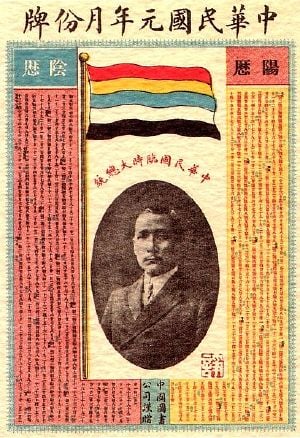
Prior to standardization in 1929, the official calendar was a lunisolar system, which remains in use today for traditional festivals such as the Lunar New Year, the Lantern Festival, and the Dragon Boat Festival.[105]
Today the standard Gregorian calendar is used for most purposes in Taiwan. The year is often denoted by the Minguo era system which starts in 1912, the year the ROC was founded. 2019 is year 108 Minguo (民國108年). This notation is most used by the government. The East Asian date format is used in Chinese (YMD, for example 2019年6月26日).
Notes
- ↑ Interior minister reaffirms Taipei is ROC's capital Taipei Times (December 5, 2013). Retrieved June 13, 2024.
- ↑ Indigenous Languages Development Act June 14, 2017. Retrieved June 13, 2024.
- ↑ Hakka Basic Act January 31, 2018. Retrieved June 13, 2024.
- ↑ 4.0 4.1 4.2 Not designated but meets legal definition
- ↑ A national language in Taiwan is legally defined as "a natural language used by an original people group of Taiwan and the Taiwan Sign Language."
- ↑ 6.0 6.1 6.2 6.3 CIA, Taiwan The World Factbook. Retrieved June 13, 2024.
- ↑ Taiwan Population 2024 World Population Review. Retrieved June 13, 2024.
- ↑ General Statistical analysis report, Population and Housing Census National Statistics, ROC (Taiwan). Retrieved June 13, 2024.
- ↑ 9.0 9.1 9.2 9.3 World Economic Outlook Database, October 2023 Edition. (Taiwan) International Monetary Fund. Retrieved June 13, 2024.
- ↑ Gini's concentration coefficient in Taiwan from 1980 to 2022 Statista. Retrieved June 13, 2024.
- ↑ 11.0 11.1 The Origin of Taiwan Ilha Formosa: the Emergence of Taiwan on the World Scene in the 17th Century.
- ↑ 12.0 12.1 James Wheeler Davidson, The Island of Formosa, Past and Present. History, People, Resources, and Commercial Prospects: Tea, Camphor, Sugar, Gold, Coal, Sulphur, Economical Plants, and Other Productions (Wentworth Press, 2016, ISBN 1372524371).
- ↑ Victor H. Mair, How to Forget Your Mother Tongue and Remember Your National Language University of Pennsylvania. Retrieved June 13, 2024.
- ↑ John W. Garver, The Sino-American Alliance: Nationalist China and American Cold War Strategy in Asia (Routledge, 1997, ISBN 0765600250).
- ↑ Constitution of the Republic of China (Taiwan) Office of the President, Republic of China (Taiwan). Retrieved June 13, 2024.
- ↑ Chinese Taipei International Olympic Committee. Retrieved June 13, 2024.
- ↑ Jacques deLisle, Taiwan in the World Health Assembly: A Victory, With Limits Brookings (May 13, 2009). Retrieved June 13, 2024.
- ↑ R.D. Larter, Intra-Oceanic Subduction Systems: Tectonic and Magmatic Processes (Geological Society of London, 2003, ISBN 978-1862391475).
- ↑ 19.0 19.1 19.2 19.3 19.4 19.5 19.6 The Republic of China Yearbook 2016 Executive Yuan. Retrieved June 13, 2024.
- ↑ John W. Olsen and Sari Miller-Antonio, The Palaeolithic in Southern China Asian Perspectives 31(2) (1992): 129–160. Retrieved June 13, 2024.
- ↑ Tianlong Jiao, The Neolithic of Southeast China: Cultural Transformation and Regional Interaction on the Coast (Cambria Press, 2007, ISBN 1934043168).
- ↑ Jared M. Diamond, Linguistics: Taiwan's gift to the world Nature 403(6771) (February 2000):709-710. Retrieved June 13, 2024.
- ↑ 23.0 23.1 John Robert Shepherd, Statecraft and Political Economy on the Taiwan Frontier, 1600–1800 (Stanford University Press, 1993, ISBN 0804720665).
- ↑ 24.0 24.1 24.2 Murray A. Rubinstein (ed.), Taiwan: A New History (Routledge, 2006, ISBN 0765614944).
- ↑ Tonio Andrade, How Taiwan Became Chinese: Dutch, Spanish, and Han Colonization in the Seventeenth Century (Columbia University Press, 2008, ISBN 023112855X).
- ↑ William Campbell, Formosa Under the Dutch: Described from Contemporary Records, with Explanatory Notes and a Bibliography of the Island (Cornell University Library, 2009, ISBN 1112450556).
- ↑ Stephane Corcuff (ed.), Memories of the Future: National identity issues and the search for a new Taiwan (Routledge, 2002, ISBN 0765607913).
- ↑ Gerard Postiglione and Jason Tan (eds.), Going to school in East Asia (Greenwood Publishing Group, 2007, ISBN 0313336334).
- ↑ Mu-chu Hsu, Culture, Self and Adaptation: The Psychological Anthropology of Two Malayo-Polynesian Groups in Taiwan (Institute of Ethnology, Academia Sinica, 1991, ISBN 9579046794).
- ↑ Robert Thomas Tierney, Tropics of Savagery: The Culture of Japanese Empire in Comparative Frame (University of California Press, 2010, ISBN 0520265785).
- ↑ Chengpang Lee, Shadow of the Colonial Power: Kominka and the Failure of the Temple Reorganization Campaign. Retrieved June 13, 2024.
- ↑ Shu LinKou Air Station: World War II Retrieved June 13, 2024.
- ↑ Chinese Civilisation Centre, China, Five Thousand Years of History and Civilization (City University of Hong Kong Press, 2007, ISBN 9629371405).
- ↑ Denny Roy, Taiwan: A Political History (Cornell University Press, 2002, ISBN 0801488052).
- ↑ This Is the Shame TIME (June 10, 1946). Retrieved June 13, 2024.
- ↑ Allan J. Shackleton, Formosa Calling: An Eyewitness Account of Conditions in Taiwan during the February 28th, 1947 Incident (Camphor Press Ltd, 2022, ISBN 978-1788691628).
- ↑ Anthony Kubek, How the Far East Was Lost: American policy and the creation of Communist China (Literary Licensing, LLC, 2012, ISBN 1258315785).
- ↑ Taiwan Timeline – Retreat to Taiwan BBC News. Retrieved June 13, 2024.
- ↑ Franklin Ng, The Taiwanese Americans (Greenwood Publishing Group, 1998, ISBN 0313297622).
- ↑ 40.0 40.1 The One-China Principle and the Taiwan Issue Taiwan Affairs Office and the Information Office of the State Council. Retrieved June 13, 2024.
- ↑ Muthiah Alagappa, Taiwan's Presidential Politics (Routledge, 2001, ISBN 0765608340).
- ↑ Taiwan Timeline – Cold war fortress BBC News. Retrieved June 13, 2024.
- ↑ Taiwan's Holocaust Remembered – 60th Commemoration New Taiwan, Ilha Formosa, 2007. Retrieved June 13, 2024.
- ↑ Caroline Gluck, Taiwan sorry for white terror era BBC News (July 16, 2008). Retrieved June 13, 2024.
- ↑ Yat-sen Sun, Julie Lee Wei, Ramon Hawley Myers, and Donald G. Gillin (eds.), Prescriptions for Saving China: Selected writings of Sun Yat-sen (Hoover Institute Press, 1994, ISBN 0817992820).
- ↑ Edmund S.K. Fung, In Search of Chinese Democracy: Civil Opposition in Nationalist China, 1929–1949 (Cambridge University Press, 2000, ISBN 0521771242).
- ↑ John F. Copper, Consolidating Taiwan's Democracy (University Press of America, 2005, ISBN 0761829776).
- ↑ Out with the old BBC News. Retrieved June 13, 2024.
- ↑ Judit Árokay, Jadranka Gvozdanović, and Darja Miyajima (eds.), Divided Languages?: Diglossia, Translation and the Rise of Modernity in Japan, China, and the Slavic World (Springer, 2014, ISBN 3319035207).
- ↑ Taiwan Timeline – Path to democracy BBC News. Retrieved June 13, 2024.
- ↑ Taiwan Party Asserts Separate Identity From China USA Today, 2007. Retrieved June 13, 2024.
- ↑ Taiwan President Calls For International Support To Defend Democracy Reuters (January 4, 2019). Retrieved June 13, 2024.
- ↑ Samson Ellis and Adela Lin, China Must Democratize for Taiwan Progress, President Tsai Says Bloomberg (January 5, 2019). Retrieved June 13, 2024.
- ↑ Bi-yu Chang, Place, Identity, and National Imagination in Post-war Taiwan (Routledge, 2015, ISBN 1138788287).
- ↑ Lindsay Maizland, Why China-Taiwan Relations Are So Tense Council on Foreign Relations (February 8, 2024). Retrieved June 13, 2024.
- ↑ Edward Wong, Taiwan's Independence Movement Likely to Wane The New York Times (March 12, 2008). Retrieved June 13, 2024.
- ↑ People's Liberation Army Airforce: Liancheng / Lianfeng Airbase Federation of American Scientists. Retrieved June 13, 2024.
- ↑ Caroline Hong, Lien, Hu share 'vision' for peace Taipei Times (April 30, 2005). Retrieved June 13, 2024.
- ↑ Tom Phillips, Leaders of China and Taiwan meet for first time in nearly seven decades The Guardian (November 7, 2015). Retrieved June 13, 2024.
- ↑ China says war with US would be a disaster as tensions mount The Guardian (June 2, 2019). Retrieved June 13, 2024.
- ↑ Eyal Propper, How China Views its National Security The Israel Journal of Foreign Affairs (May 2008). Retrieved June 13, 2024.
- ↑ Jean-Marie Henckaerts, The International Status of Taiwan in the New World Order: Legal and Political Considerations (Springer, 1996, ISBN 9041109293).
- ↑ Pobzeb Vang, Five Principles of Chinese Foreign Policies (AuthorHouse, 2008, ISBN 1434369714).
- ↑ Stephen J. Yates, The Taiwan Relations Act After 20 Years: Keys to Past and Future Success The Heritage Foundation (April 16, 1999). Retrieved June 13, 2024.
- ↑ James A. Kelly, Overview of US Policy Towards Taiwan US Department of State (April 21, 2004). Retrieved June 13, 2024.
- ↑ Taiwan and the United Nations New Taiwan (February 24, 2004). Retrieved June 13, 2024.
- ↑ Taiwan UNPO, July 19, 2018. Retrieved June 13, 2024.
- ↑ John Tkacik, John Tkacik on Taiwan: Taiwan's 'undetermined' status Taipei Times (May 13, 2009). Retrieved June 13, 2024.
- ↑ Joy Su, WHO application: a question of health or politics? Taipei Times (May 19, 2004). Retrieved June 13, 2024.
- ↑ Jennifer Dobner, Taiwan flags in Salt Lake ruffle a few feelings The Deseret News (February 10, 2002). Retrieved June 13, 2024.
- ↑ David Shambaugh (ed.), Power Shift: China and Asia's New Dynamics (University of California Press, 2006, ISBN 9780520245709).
- ↑ 72.0 72.1 Jim Hoare and Susan Pares, A Political and Economic Dictionary of East Asia (Routledge, 2005, ISBN 1857432584).
- ↑ Tom Ginsburg, Judicial Review in New Democracies (Cambridge University Press, 2003, ISBN 0521817153).
- ↑ Taiwan assembly passes changes BBC News (June 7, 2005). Retrieved June 13, 2024.
- ↑ Kanishka Jayasuriya (ed.), Law, Capitalism and Power in Asia (Routledge, 1999, ISBN 0415197422).
- ↑ Country profile: Taiwan BBC News. Retrieved June 13, 2024.
- ↑ 77.0 77.1 Ralph Cossa, Looking behind Ma's 'three noes' Taipei Times (January 21, 2008). Retrieved June 13, 2024.
- ↑ Taiwan party asserts separate identity Associated Press (September 30, 2007). Retrieved June 13, 2024.
- ↑ Taiwan Flashpoint: Independence debate BBC News. Retrieved June 13, 2024.
- ↑ The Official Position of the Republic of China (Taiwan) on the People's Republic of China's Anti-Secession (Anti-Separation) Law Mainland Affairs Council (March 29, 2005). Retrieved June 13, 2024.
- ↑ M. Taylor Fravel, Towards Civilian Supremacy: Civil-Military Relations in Taiwan's Democratization Armed Forces & Society 29(1) (2002): 57–84. Retrieved June 13, 2024.
- ↑ Michael Swaine, Taiwan: Foreign and Defense Policymaking (Rand Publishing, 2001, ISBN 0833030949).
- ↑ Ralph Clough, "Taiwan under Nationalist Rule, 1949–1982," in Roderick MacFarquahar and John K. Fairbank (eds.), Cambridge History of China, Vol. 15: The People's Republic Part 2 (Cambridge University Press, 1991, ISBN 0521243378), 837.
- ↑ Phil Harding, Taiwan's Grand Hotel welcome for Chinese visitors BBC News (January 23, 2010). Retrieved June 13, 2024.
- ↑ 2008 White Paper On Taiwan Industrial Technology. Retrieved June 13, 2024.
- ↑ Taiwan Flashpoint: China's Stance BBC News. Retrieved June 13, 2024.
- ↑ Privatization Set in Motion Taiwan Today (December 1, 2005). Retrieved June 13, 2024.
- ↑ Separate Customs Territory of Taiwan, Penghu, Kinmen and Matsu (Chinese Taipei) and the WTO World Trade Organization. Retrieved June 13, 2024.
- ↑ Robert Ash, John W. Garver, and Penelope Prime (eds.), Taiwan's Democracy: Economic and Political Challenges (Routledge, 2011, ISBN 0415604575).
- ↑ Douglas C. Smith, Middle Education in the Middle Kingdom: The Chinese Junior High School in Modern Taiwan (Praeger, 1997, ISBN 0275956415).
- ↑ The Repubic of China Yearbook 2014. Retrieved June 13, 2024.
- ↑ An Overview of Taiwan's Indigenous Groups Government Information Office, 2006. Retrieved June 13, 2024.
- ↑ 93.0 93.1 93.2 The Republic of China Yearbook 2011 Government Information Office, Republic of China (Taiwan). Retrieved June 13, 2024.
- ↑ Official documents issued in Aboriginal languages Taipei Times (July 20, 2017). Retrieved June 13, 2024.
- ↑ Elizabeth Zeitoun and Ching-Hua Yu, The Formosan Language Archive: Linguistic Analysis and Language Processing Computational Linguistics and Chinese Language Processing 10(2) (June 2005): 167-200. Retrieved June 13, 2024.
- ↑ Constitution of the Republic of China Chapter II, Article 13 Retrieved June 13, 2024.
- ↑ Athena Tacet, Islam in Taiwan: Lost in tradition Al-Jazeera (December 31, 2014). Retrieved June 13, 2024.
- ↑ Old Collection & New Additions National Palace Museum. Retrieved June 13, 2024.
- ↑ Keith Bradsher, China agrees to lend art to museum in Taiwan The New York Times (February 16, 2009. Retrieved June 13, 2024.
- ↑ Deng Ning, Kelly Her (trans.), Innovative Taiwan convenience store giants win over customers Taiwan Today (August 26, 2016). Retrieved June 13, 2024.
- ↑ Taiwan scores first table tennis gold in Paris win Taipei Times (May 21, 2013). Retrieved June 13, 2024.
- ↑ Taiwanese Olympic Medals in Table Tennis Olympian Database. Retrieved June 13, 2024.
- ↑ Victorious Tseng takes No. 1 ranking Taipei Times (February 14, 2011). Retrieved June 13, 2024.
- ↑ Richard Hazeldine, Jujitsu, korfball put Taiwan back on winning track Taipei Times (July 22, 2009). Retrieved June 13, 2024.
- ↑ Holidays and Festivals in Taiwan Government Information Office, ROC. Retrieved June 13, 2024.
ReferencesISBN links support NWE through referral fees
- Alagappa, Muthiah. Taiwan's Presidential Politics. Routledge, 2001. ISBN 0765608340
- Andrade, Tonio. How Taiwan Became Chinese: Dutch, Spanish, and Han Colonization in the Seventeenth Century. Columbia University Press, 2008, ISBN 023112855X
- Árokay, Judit, Jadranka Gvozdanović, and Darja Miyajima (eds.). Divided Languages?: Diglossia, Translation and the Rise of Modernity in Japan, China, and the Slavic World. Springer, 2014. ISBN 3319035207
- Ash, Robert, John W. Garver, and Penelope Prime (eds.). Taiwan's Democracy: Economic and Political Challenges. Routledge, 2011. ISBN 0415604575
- Campbell, William. Formosa Under the Dutch: Described from Contemporary Records, with Explanatory Notes and a Bibliography of the Island. Cornell University Library, 2009. ISBN 1112450556
- Chang, Bi-yu. Place, Identity, and National Imagination in Post-war Taiwan. Routledge, 2015. ISBN 1138788287
- Chinese Civilisation Centre. China, Five Thousand Years of History and Civilization. City University of Hong Kong Press, 2007. ISBN 9629371405
- Copper, John F. Consolidating Taiwan's Democracy. University Press of America, 2005. ISBN 0761829776
- Corcuff, Stephane (ed.). Memories of the future: national identity issues and the search for a new Taiwan. Routledge, 2002, ISBN 0765607913
- Davidson, James Wheeler. The Island of Formosa, Past and Present. History, People, Resources, and Commercial Prospects: Tea, Camphor, Sugar, Gold, Coal, Sulphur, Economical Plants, and Other Productions. Wentworth Press, 2016. ISBN 1372524371
- Fung, Edmund S.K. In Search of Chinese Democracy: Civil Opposition in Nationalist China, 1929–1949. Cambridge University Press, 2000. ISBN 0521771242
- Garver, John W. The Sino-American Alliance: Nationalist China and American Cold War Strategy in Asia. Routledge, 1997. ISBN 0765600250
- Ginsburg, Tom. Judicial Review in New Democracies. Cambridge University Press, 2003. ISBN 0521817153
- Henckaerts, Jean-Marie. The International Status of Taiwan in the New World Order: Legal and Political Considerations. Springer, 1996. ISBN 9041109293
- Hoare, Jim, and Susan Pares. A Political and Economic Dictionary of East Asia. Routledge, 2005. ISBN 1857432584
- Hsu, Mu-chu. Culture, Self and Adaptation: The Psychological Anthropology of Two Malayo-Polynesian Groups in Taiwan. Institute of Ethnology, Academia Sinica, 1991. ISBN 9579046794
- Jayasuriya, Kanishka (ed.). Law, Capitalism and Power in Asia. Routledge, 1999. ISBN 0415197422
- Jiao, Tianlong. The Neolithic of Southeast China: Cultural Transformation and Regional Interaction on the Coast. Cambria Press, 2007. ISBN 1934043168
- Kubek, Anthony. How the Far East Was Lost: American policy and the creation of Communist China. Literary Licensing, LLC, 2012. ISBN 1258315785
- Larter, R.D. Intra-Oceanic Subduction Systems: Tectonic and Magmatic Processes. Geological Society of London, 2003. ISBN 978-1862391475
- MacFarquahar, Roderick, and John K. Fairbank (eds.). The Cambridge History of China, Vol. 15: The People's Republic, Part 2: Revolutions within the Chinese Revolution, 1966-1982. Cambridge University Press, 1991. ISBN 0521243378
- Ng, Franklin. The Taiwanese Americans. Greenwood Publishing Group, 1998. ISBN 0313297622
- Postiglione,Gerard, and Jason Tan (eds.). Going to school in East Asia. Greenwood Publishing Group, 2007. ISBN 0313336334
- Roy, Denny. Taiwan: A Political History. Cornell University Press, 2002. ISBN 0801488052
- Rubinstein, Murray A. (ed.). Taiwan: A New History. Routledge, 2006. ISBN 0765614944
- Shackleton, Allan J. Formosa Calling: An Eyewitness Account of Conditions in Taiwan during the February 28th, 1947 Incident. Camphor Press Ltd, 2022. ISBN 978-1788691628
- Shambaugh, David (ed.). Power Shift: China and Asia's New Dynamics. University of California Press, 2006. ISBN 9780520245709
- Shepherd, John Robert. Statecraft and Political Economy on the Taiwan Frontier, 1600–1800. Stanford University Press, 1993. ISBN 0804720665
- Smith, Douglas C. Middle Education in the Middle Kingdom: The Chinese Junior High School in Modern Taiwan. Praeger, 1997. ISBN 0275956415
- Sun, Yat-sen, Julie Lee Wei, Ramon Hawley Myers, and Donald G. Gillin (eds.). Prescriptions for Saving China: Sselected writings of Sun Yat-sen. Hoover Institute Press, 1994. ISBN 0817992820
- Swaine, Michael. Taiwan: Foreign and Defense Policymaking. Rand Publishing, 2001. ISBN 0833030949
- Tierney, Robert Thomas. Tropics of Savagery: The Culture of Japanese Empire in Comparative Frame. University of California Press, 2010. ISBN 0520265785
- Vang, Pobzeb. Five Principles of Chinese Foreign Policies. AuthorHouse, 2008. ISBN 1434369714
External links
All links retrieved June 13, 2024.
- Taiwan country profile BBC News
- Taiwan flashpoint BBC News
- Taiwan US Department of State
- Taiwan Countries and their Cultures
- Taiwan World Factbook
- Taiwan Travel Information and Travel Guide Lonely Planet
- Taiwan's 400 years of history New Taiwan, Ilha Formosa
- Chinese Taipei Organisation for Economic Co-operation and Development (OECD)
- Office of the Government
- Office of the President
- Executive Yuan
- Judicial Yuan
- Control Yuan
- Ministry of Foreign Affairs
- Taipei Economic & Cultural Representative Office in the US
- Taiwan, Waves of Wonder Tourism Bureau, Republic of China (Taiwan)
| SARs | |||
Sometimes included: Singapore · Vietnam · Russian Far East
Credits
New World Encyclopedia writers and editors rewrote and completed the Wikipedia article in accordance with New World Encyclopedia standards. This article abides by terms of the Creative Commons CC-by-sa 3.0 License (CC-by-sa), which may be used and disseminated with proper attribution. Credit is due under the terms of this license that can reference both the New World Encyclopedia contributors and the selfless volunteer contributors of the Wikimedia Foundation. To cite this article click here for a list of acceptable citing formats.The history of earlier contributions by wikipedians is accessible to researchers here:
The history of this article since it was imported to New World Encyclopedia:
Note: Some restrictions may apply to use of individual images which are separately licensed.


